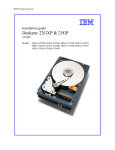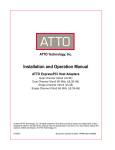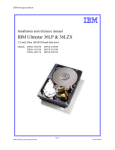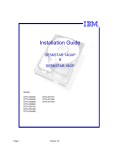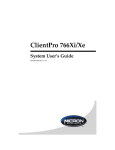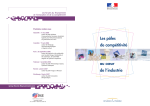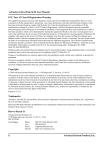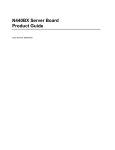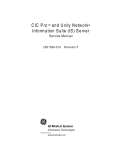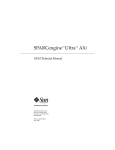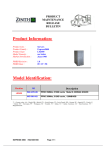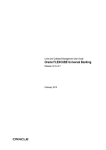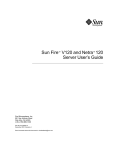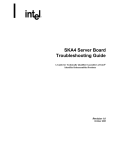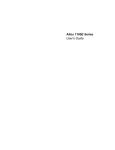Download Intel Desktop Board MU440EX Motherboard
Transcript
IBM storage products Installation guide Ultrastar 18ES Multi-mode SE/LVD Models: DNES-309170 DNES-318350 IBM storage products Table of contents Introduction . . . . . . . . . . . . . . . . . . . . . . . . . . . . . . . . . . . . . . . . . . . . . . . . . . . . . . . . . . . . . . . Page 3 Hardware description . . . . . . . . . . . . . . . . . . . . . . . . . . . . . . . . . . . . . . . . . . . . . . . . . . . . . . . . Page 4 Hard disk drive handling guide . . . . . . . . . . . . . . . . . . . . . . . . . . . . . . . . . . . . . . . . . . . . . . . . Page 5 Hard disk drive installation flow chart . . . . . . . . . . . . . . . . . . . . . . . . . . . . . . . . . . . . . . . . . . . Page 6 Step 1: Installation checklist . . . . . . . . . . . . . . . . . . . . . . . . . . . . . . . . . . . . . . . . . . . . . . . . . . Page 7 Step 2: Prepare for installation . . . . . . . . . . . . . . . . . . . . . . . . . . . . . . . . . . . . . . . . . . . . . . . . Page 8 Step 3: Jumper Settings . . . . . . . . . . . . . . . . . . . . . . . . . . . . . . . . . . . . . . . . . . . . . . . . . . . . . . Page 9 Step 4: Mounting . . . . . . . . . . . . . . . . . . . . . . . . . . . . . . . . . . . . . . . . . . . . . . . . . . . . . . . . . . Page 12 Step 5: Connectors . . . . . . . . . . . . . . . . . . . . . . . . . . . . . . . . . . . . . . . . . . . . . . . . . . . . . . . . . Page 13 Step 6: Complete physical installation . . . . . . . . . . . . . . . . . . . . . . . . . . . . . . . . . . . . . . . . . Page 14 Step 7: Installation and configuration . . . . . . . . . . . . . . . . . . . . . . . . . . . . . . . . . . . . . . . . . . Page 14 Step 8: FDISK . . . . . . . . . . . . . . . . . . . . . . . . . . . . . . . . . . . . . . . . . . . . . . . . . . . . . . . . . . . . . Page 17 Step 9: Formatting . . . . . . . . . . . . . . . . . . . . . . . . . . . . . . . . . . . . . . . . . . . . . . . . . . . . . . . . . Page 19 Step 10: Operating system installation . . . . . . . . . . . . . . . . . . . . . . . . . . . . . . . . . . . . . . . . . Page 19 Appendix . . . . . . . . . . . . . . . . . . . . . . . . . . . . . . . . . . . . . . . . . . . . . . . . . . . . . . . . . . . . . . . . . Page 20 Glossary . . . . . . . . . . . . . . . . . . . . . . . . . . . . . . . . . . . . . . . . . . . . . . . . . . . . . . . . . . . . . . . . . Page 26 Page 2 IBM Technical Group Support Center version 1.1 25L17811G10 IBM storage products Introduction This manual was prepared to help you install your IBM Ultrastar 18ES hard drive in most computer systems. If you do not feel comfortable installing this drive yourself, contact a qualified installer to assist you. International Business Machines Corporation provides this publication "AS IS" without warranty of any kind, either express or implied, including, but not limited to, the implied warranties of merchantability or fitness for a particular purpose. Some states do not allow disclaimers of express or implied warranties in certain transactions. Therefore, this statement may not apply to you. This publication could include technical inaccuracies or typographical errors. Product data and specifications are subject to change without notice. Changes are periodically made to the information herein; these changes will be incorporated in new editions of the publication. IBM may make improvements or changes in the products or the program described in this publication at any time. This publication may contain reference to or information about IBM products (machines and programs), programming, or services that are not available in your country. Such references or information must not be construed to mean that IBM intends to make available such IBM products, programming, or services in your country. Product description data contained herein represents IBM’s design objectives and is provided for comparison among IBM products; actual results may vary based on a variety of factors. Except as explicitly stated in the Warranty section of this Guide, the product data contained herein does not constitute a warranty. Questions regarding IBM warranty terms or the methodology used to derive data should be referred to an IBM representative. Technical information about IBM hard disk drive products can be obtained via the Internet at: http://www.ibm.com/harddrive or by calling the IBM Hard Disk Drive Technical Support Center at 888.426.5214. ©Copyright International Business Machines Corporation 1999. All rights reserved. Note to US Government Users - Documentation related to restricted rights - Use, duplication, or disclosure is subject to restrictions set forth in GSA ADP Schedule Contract with IBM Corp. IBM is a registered trademark of the International Business Machines Corporation. The following are also trademarks or registered trademarks of the International Business Machines Corporation in the United States, other countries, or both: Ultrastar and OS/2. Any other products or trademarks are the property of their respective owners. Page 3 IBM Technical Group Support Center version 1.1 25L17811G10 IBM storage products Hardware description The Ultrastar 18ES is available in various models with the following options: ! ! ! ! ! Capacity of 18 or 9GB 50, 68, or 80 pin connectors 50 pin SCSI connectors use the SCSI A connector. 68 pin SCSI connectors use the SCSI P connector. 80 pin SCSI connectors use the SCA-2 connector Capacity 9GB 9GB 9GB 9GB 18GB 18GB 18GB 18GB Model DNES-309170 DNES-309170 DNES-309170 DNES-309170 DNES-318350 DNES-318350 DNES-318350 DNES-318350 SCSI Pins/Connector Type 50 / Unitized Connector 68 / Unitized Connector 68 / Unitized Connector 80 / SCA-2 50 / Unitized Connector 68 / Unitized Connector 68 / Unitized Connector 80 / SCA-2 SCSI Electrical Signal Type Ultra SCSI Ultra SCSI Low Voltage Differential (Ultra2) Low Voltage Differential (Ultra2) Ultra SCSI Ultra SCSI Low Voltage Differential (Ultra2) Low Voltage Differential (Ultra2) These drives offer an advanced LVD interface that supports transfer rates of up to 80 MB/sec. To take advantage of the higher transfer rate of 80 MB/sec, your computer will need to have a controller that supports the LVD interface. If you have a SCSI controller that does not support this interface, the drive will still function, but will be limited to data transfer speeds significantly lower than 80MB/sec due to the lower speed of your controller. If you have a slower controller, you may wish to purchase an LVD controller card to take advantage of Ultrastar’s 80 MB/sec data transfer rate. An LVD controller card will fit into any available slot in your computer. To determine if your current controller card is LVD, check the documentation that came with your controller or contact the controller manufacturer. If you currently have single-ended wide SCSI drives and a non-LVD controller, you may still attach the LVD model Ultrastar 18ES to the existing cable. If you choose to replace your non-LVD controller with an LVD model, in most cases, single-ended wide SCSI drives can be attached to the same bus with an LVD drive. However, there are some LVD controllers that do not support single-ended wide SCSI drives. Check the documentation that came with your controller or contact the manufacturer to ensure that your LVD controller will support single-ended wide SCSI drives. The Ultrastar 18ES family is ideal use by video producers and movie editors. These drives are designed to work with MMX systems. Compatibility listings are included in the appendix. Before you begin installation, please read the “Hard disk drive handling guide” on the following page. Page 4 IBM Technical Group Support Center version 1.1 25L17811G10 IBM storage products Hard disk drive handling guide These notes are designed to provide a simple overview of the need for caution when handling a disk drive. Disk drives can be easily damaged by electrical static shock or rough handling. In order to minimize the risk of damage to a disk drive, it is essential that the drive be handled while resting on a cushioned surface (which is electrostatically safe). Examples of static-safe mats available at the time of this printing are 3M's 8210 table mat and 3M's "First Touch" computer pad. Great care should be taken when handling disk drives. Do not bump them against any object. When attaching brackets or mounting the drive in the computer, be very careful. It is very easy to unintentionally cause shocks which exceed specifications. Please note that the capacity of each disk drive to withstand electrical or mechanical shock varies according to its design. The IBM Hard Disk Drive Technical Support Center can advise you on the suitability of your Ultrastar drive for a specific application. Damage incurred to a drive might not be immediately evident and could cause the drive to fail months later. Page 5 IBM Technical Group Support Center version 1.1 25L17811G10 IBM storage products Hard disk drive installation flow chart Step 1 Installation checklist/assemble needed equipment Page 7 Step 2 Prepare for installation Page 8 Step 3 Jumper settings Page 9 Step 4 Mounting the drive Page 12 Step 5 Connectors Page 13 Step 6 Complete physical installation Page 14 Step 7 Installation and configuration Page 14 Step 8 FDISK Page 17 Step 9 Formatting Page 19 Step 10 Operating system installation Page 19 Page 6 IBM Technical Group Support Center version 1.1 25L17811G10 IBM storage products Step 1: Installation checklist To install the Ultrastar drive you may need the following items, depending on your computer’s components: ! The installation kit (as shown in the diagram below) containing the Ultrastar drive, 4 mounting screws, and any related publications. Save the box the drive came in. Screwdriver Hard Drive Installation Guide Jumpers Screws Installation Guide ! The documentation that came with your computer or storage enclosure. ! A small, flat-blade screwdriver. ! A SCSI controller, which is either built-in or an adapter inside your computer, and any related documentation. ! Mounting brackets, if required for your computer. Contact your place of purchase if you are not certain if mounting brackets are required. ! A bootable DOS diskette. (See the section entitled Making a bootable diskette in the appendix.) ! If you are replacing an older internal drive with the new Ultrastar drive and want to copy all of the files from the older drive to the new drive, you may need additional software. (See the section entitled Drive copy in the Appendix.) Page 7 IBM Technical Group Support Center version 1.1 25L17811G10 IBM storage products Step 2: Prepare for installation Begin by backing up your existing drive to avoid any loss of data during installation. (See the section entitled Backup and Restore in the Appendix.) After completing the backup, shut down as normal. Opening your computer ! Turn the system off. ! Unplug the power cord from the wall outlet. ! Remove all cables from the back of your computer, labeling them if necessary. ! Remove the cover from your computer. (Consult your user's guide for instructions if needed.) Unpackaging your hard drive ! If available, use an ESD (Electronic Static Discharge) wrist strap while handling your drive. ! If an ESD wrist strap is not available, discharge static electricity by establishing a common voltage between your body and the hard drive. Simultaneously touch the hard drive in its antistatic bag and an unpainted metal surface on the outside of your computer system with your bare hands. ! Remove the drive from the antistatic package that it was shipped in. Handle the drive only by the sides and avoid excessive movement until the drive has been mounted. ! Do not touch the main computer chip board. ! Do not drop the drive. A drop from only 1/4 inch could permanently damage your hard drive. ! Place the drive carefully on a static free area. ! Record the following information: Drive Model ________________ P/N __________________ ____________________ Date of Purchase_________________ Place of Purchase_________________ Drive Serial # Note:Do not low-level format your drive! IBM drives are low-level formatted by the manufacturer and reformatting may cause permanent damage to your drive and your system. (See the section entitled Utilities in the Appendix.) Page 8 IBM Technical Group Support Center version 1.1 25L17811G10 IBM storage products Step 3: Jumper settings The jumper settings are found on the hard drive on the opposite end of the interface connector (see diagram page 12). They are physical settings that must be changed for different uses of a hard drive. As shown below, there are two option jumper blocks located on the card of 50 and 68 pin models of the Ultrastar 18ES. 80 pin models have only one option jumper block. SCSI ID Jumpers Each SCSI device will need to have its own SCSI ID. You can use ID 0 through ID 15, reserving ID 7 for your controller card. Follow the table below to set an ID on your SCSI drive. Bit 3 off off off off off off off off on on on on on on on on Bit 2 off off off off on on on on off off off off on on on on Bit 1 off off on on off off on on off off on on off off on on Bit 0 off on off on off on off on off on off on off on off on Address 0 1 2 3 4 5 6 7* 8 9 10 11 12 13 14 15 *Reserved for controller card SCSI address determination Page 9 IBM Technical Group Support Center version 1.1 25L17811G10 IBM storage products Drive Termination The SCSI bus must be terminated at both ends of the bus. If you have a single-ended Ultrastar 18ES, active termination is supplied on the jumper block. Ultra2 SCSI (LVD) models do not have onboard active termination. You will need to supply an external Ultra2 compatible terminator. Termination Power Some controllers may require the drive to supply 5 volts of power to the bus to aid termination. If your controller requires this, place a jumper on the Termination Power Enable jumpers to the side of the jumper block. These pins require a 2.54mm jumper shunt. Auxiliary Option Jumper Block The 68 pin models contain an auxiliary connector that replicates some of the functions provided by the front option jumper block. The auxiliary connector should only be used if you have a combination “ganged” switch, typically found in external drive enclosures. The front option block and the auxiliary option block may not be used simultaneously. Auxiliary Connector :::::: SCSI Address Enable SCSI Terminator ID2 ID0 +5V ID3 ID1 11 9 7 5 3 1 12 10 8 6 4 2 Reserved Reserved Ground LED Cathod Note: Pin #9 is valid only for single-ended model. LVD/SE mult-mode model has no terminator. Auxiliary connector Page 10 IBM Technical Group Support Center version 1.1 25L17811G10 IBM storage products Additional Jumper Options The Ultrastar drives offer additional options on the jumper block. See Appendix for details of the additional jumper options shown below. Option Jumper Block J-4 Option Jumper Block J-6 SCSI Bus Open LED Anode Ground 12 11 10 9 8 7 6 5 4 3 2 1 0 1 2 3 SCSI ID Bits Enable Auto Spin Up LED Cathod Disable SCSI Parity Check Delay Start 6/12 G F E Ground D C B A Open Reserved Enable Terminator Power Supply Enable SCSI Terminator Disable Unit Attention Enable Auto Start Delay Enable TI-SDTR/WDTR *80 pin models do not have Option Jumper Block J-6 *Position #6 is "Force Single-ended Mode" on multi-mode SE/LVD models. Jumper settings for single-ended models Option Jumper Block J-4 Option Jumper Block J-6 SCSI Bus Open LED Anode Ground 12 11 10 9 8 7 6 5 4 3 2 1 0 1 2 3 SCSI ID Bits Enable Auto Spin Up LED Cathod Disable SCSI Parity Check Delay Start 6/12 Enable Auto Start Delay G F E Ground D C B A Open Reserved Enable Terminator Power Supply Force SE Mode Disable Unit Attention Enable TI-SDTR/WDTR *80 pin models do not have Option Jumper Block J-6 Jumper settings for Ultra2 SCSI (LVD) models Page 11 IBM Technical Group Support Center version 1.1 25L17811G10 IBM storage products Step 4: Mounting After setting the jumpers, mount the hard drive in your system. The Ultrastar drive can be mounted with any of its six surfaces facing down. See below for mounting hole locations. Mounting hole locations You must ensure that the drive has sufficient air flow. Mount the drive in the system using four 6-32 UNC screws. The maximum screw length is 3.5 mm for the side holes and 6 mm for the bottom holes. Mount the drive securely enough to prevent excessive motion or vibration. If you are mounting your drive in a 5 inch bay, you may need to purchase mounting brackets from your computer manufacturer for the drive to be mounted securely. Page 12 IBM Technical Group Support Center version 1.1 25L17811G10 IBM storage products Step 5: Connectors 50 and 68 pin drives After the drive has been carefully mounted, connect the SCSI cable and the power cable to the drive. (Note that the SCSI connector and power connector are keyed for proper insertion.) 50 pin connector 68 pin connector Page 13 IBM Technical Group Support Center version 1.1 25L17811G10 IBM storage products 80 pin drives 80 pin drives are to be plugged into backplanes of servers and require no cables. If you have an 80 pin drive that you want to connect to a 68 pin SCSI cable, you will need to purchase a converter. Be aware that not all SCA converters support LVD mode. 80 pin connector Step 6: Complete physical installation Verify that the cable is properly connected to the SCSI controller. Replace the cover on the computer, connect all cables, and plug the power cord into the wall. Step 7: Installation and configuration If you have just added a SCSI controller card, follow the manufacturer’s instructions to install the card. Boot computer “Booting” means turning on your computer. Turn on your computer after you have inserted a bootable diskette. You should see the drive listed when the system is booting. Note: The example below uses the Adaptec 3950U2B controller and the Model DRVS-09D drive. Adaptec AHA - 3950U2B SCSI BIOS v2.10.0 (c) 1998 Adaptec. Inc. All Rights Reserved. Press <Ctrl> <A> for SCSISelect (TM) Utility Ch A. SCSI ID: 0 IBM DRVS09D ULTRA2-LVD Page 14 IBM Technical Group Support Center version 1.1 25L17811G10 IBM storage products You can, at this time, press [CTRL] [A] to enter the Adaptec SCSI setup utility. The following screen will appear. Adaptec AHA-3950U2B SCSISelect (TM) Utility v2.10.0 AHA-3950U2B at Bus: Device 00:Fh Would you like to configure the host adapter, or run the SCSI disk utilities. Select the option and press Enter. Press F5 to switch between color and monochrome modes. Options Configure/View Host Adapter Settings SCSI Disk Utilities Select the channel to which your drive is attached. The screen below will follow. Adaptec AHA-3950U2B SCSISelect (TM) Utility v2.10.0 You have an AHA-3950U2B SCSI host adapter in your system. Move the cursor to the bus:device:channel of the one to be configured and press <Enter>. Bus:Device:Channel 00:0D:A 00:0D:B <F5> - Toggle color/monochrome Arrow keys to move cursor, <Enter> to select option, <Esc> to exit ( * = default) Page 15 IBM Technical Group Support Center version 1.1 25L17811G10 IBM storage products Select the first option Configure/View Host Adapter Settings. The next screen is shown below with the default settings. Adaptec AHA-3950U2B SCSISelect (TM) Utility v2.10.0 AHA-3950U2B at Bus:00h Device:0Dh Channel:B Configuration Host Adapter SCSI ID..................................................................................... 7 SCSI Parity Checking..................................................................................... Enabled Host Adapter SCSI Termination...................................................................... Automatic Boot Device Options....................................................................................... Press <Enter> SCSI Device Configuration............................................................................. Press <Enter> Advanced Configuration Options.....................................................................Press <Enter> <F6> - Reset to Host Adapter Defaults BIOS Information Interrupt (IRQ) Channel.........................................................................................10 I/0 Port Address.....................................................................................................F400h Arrow keys to move cursor, <Enter> to select option, <Esc> to exit ( * = default) You can accept the default settings with Host Adapter SCSI Termination set to Automatic. If you wish to accept the default settings, press [ESC] to return to the previous menu. Select the SCSI utilities. Adaptec AHA-3950U2B SCSISelect (TM) Utility v2.10.0 AHA-3950U2B at Bus:00h Device:0Dh Channel:A Select SCSI Disk and press <Enter> SCSI ID #0: IBM SCSI ID #1: No device DRVSO9D SCSI ID #2: No device SCSI ID #3: No device SCSI ID #4: No device SCSI ID #5: No device SCSI ID #6: No device SCSI ID #7: AHA-3950U2B SCSI ID #8: No device SCSI ID #9: No device SCSI ID #10: No device SCSI ID #11: No device SCSI ID #12: No device SCSI ID #13: No device SCSI ID #14: No device SCSI ID #15: No device ULTRA2-LVD Arrow keys to move cursor, <Enter> to select option, <Esc> to exit (*=default) This shows all devices attached to the bus. To perform a Verify Media, highlight the drive you would like to verify and press [ENTER]. Select Verify Media from the options. If you wish to accept all settings, press [ESC] to exit out of the Adaptec settings. Page 16 IBM Technical Group Support Center version 1.1 25L17811G10 IBM storage products Step 8: FDISK Boot to a bootable diskette and type FDISK at the A:\ prompt. If Windows® 95 OSR2 or Windows® 98 is used, the following screen will appear. Your computer has a disk larger than 512 MB. This version of Windows includes improved support for large disks, resulting in more efficient use of disk space on large drives, and allowing disks over 2 GB to be formatted as a single drive. IMPORTANT: If you enable large disk support and create any new drives on this disk, you will not be able to access the new drive(s) using other operating systems, including some versions of Windows 95 and Windows NT, as well as earlier versions of Windows and MS-DOS. In addition, disk utilities that were not designed explicitly for the FAT32 file system will not be able to work with this disk. If you need to access this disk with other operating systems or older disk utilities, do not enable large drive support. Do you wish to enable large disk support (Y/N)...............? [N] Type Y to select the FAT 32 file system. Type N to select the FAT 16 file system. The following screen allows you to create partitions. If you have more than 1 drive there will be 5 options. Option 5 allows you to select the drive you wish to partition. PC DOS Version 7.0 Fixed Disk Setup Program Copyright IBM Corporation 1983-1994 FDISK Options Current fixed disk drive: 1 Choose one of the following: 1. Create DOS partition or Logical DOS Drive 2. Set active partition 3. Delete partition or Logical DOS Drive 4. Display partition information 5. Change current fixed disk drive Enter choice:[1] Press ESC to exit FDISK Select option 1 to create a DOS partition. The screen on the following page will appear. Page 17 IBM Technical Group Support Center version 1.1 25L17811G10 IBM storage products Select option 1 to create a DOS partition. The screen below will appear. Create DOS Partition or Logical DOS Drive Choose one of the following: 1. Create Primary DOS Partition 2. Create Extended DOS Partition 3. Create Logical DOS Drive(s) in the Extended DOS partition. Enter choice: [3] Press ESC to return to FDISK Options Select option 1 to Create a Primary DOS Partition. If this is to be the boot drive, set this partition to “Active”. Press ESC to return to the FDISK options. Create an Extended DOS Partition by selecting option 1 from the main menu and option 2 from the second menu. (Both menus shown above.) Note: The Maximum Capacity shows only 8455 MB instead of 9130 MB. This is because the BIOS of some systems recognizes a Megabyte as 1,048,576 bytes (binary). Drive manufacturers recognize a Megabyte as 1,000,000 bytes (decimal). The capacities are the same in actual number of bytes. After creating the Extended DOS Partition, press ESC to return to the FDISK main menu. Select option 1 to create a Logical DOS Drive, then option 3 to create a Logical DOS Drive in an Extended Partition. Create Logical DOS Drive(s) in the Extended DOS Partition No logical drives defined Total Extended DOS Partition size is 1047 Mbytes (1 MByte = 1048576 bytes) Maximum space available for logical drive is 1047Mbytes (100%) Enter logical drive size in Mbytes or percent of disk space (%).....[1047] Press ESC to return to FDISK Options Page 18 IBM Technical Group Support Center version 1.1 25L17811G10 IBM storage products Press ESC to return to FDISK and press ESC again to restart the system. You must restart the system for the partitions to be recognized. Step 9: Formatting The drive will need to be formatted before an operating system can be loaded. Format the Primary partition and any Extended partitions that have been made. After booting from a bootable diskette, run FDISK, option 4 to display the partition information. This is helpful to review drive letter assignments. Note the drive letters to ensure proper formatting. Press ESC to return to the main menu and exit FDISK. At the A:\ prompt type format x: /s (where x is the drive letter). The /s option will make your hard drive bootable by copying the system files to the hard drive. If you do not want this drive to be bootable, do not use the /s command. You will see the following warning: WARNING: ALL DATA ON NON-REMOVABLE DISK DRIVE C: WILL BE LOST! Proceed with Format (Y/N)? Type Y for yes. There should be no data on the new drive. The time it takes to format the drive is dependent upon its size. When the drive has finished formatting, format the next logical drive, in this case D: by typing format d: You will get the same message. Select Y. Step 10: Operating system installation After the drive has been formatted, install an operating system. Page 19 IBM Technical Group Support Center version 1.1 25L17811G10 IBM storage products Appendix Making a bootable diskette If you do not have a DOS bootable diskette, you may want to make one. This will be necessary for installing your new hard disk drive and in case of system failure. The DOS bootable diskette will contain files necessary to boot your system. These files are called system files. You will also want some utilities on your bootable diskette. Following are the instructions needed to add both the system files and the other helpful utilities. ! Make sure your computer is on and you insert a diskette in drive A. ! At the C:\ prompt, type FORMAT A: /S and press [ENTER]. ! Press [ENTER] again, unless you want to label your diskette. ! Add the utilities. To do so, use some simple copy commands. " " " " " " Type cd Windows at the C:\ prompt, press [ENTER]. Type copy fdisk.exe a:, press [ENTER]. Type copy format.com a:, press [ENTER]. Type copy sys.com a:, press [ENTER]. Type copy chkdsk.exe a:, press [ENTER]. Type copy debug.exe a:, press [ENTER]. ! Type cd. ! Remove diskette from drive A: ! Write protect the diskette by sliding the small plastic tab on the diskette in the up position. ! Test the diskette. " " " " ! Turn off your computer. Insert the diskette in drive A: Turn on your computer. When you get to the A:\ prompt type c:, press [ENTER]. If any of these steps did not work, start again at step 1. Page 20 IBM Technical Group Support Center version 1.1 25L17811G10 IBM storage products Jumper block information The jumper block is a block of pins located on the hard drive. When these pins are shorted with shunts (jumpers), the drive will behave in certain ways. A shunt is a small piece of plastic with metal inside that shorts out the connection between 2 pins when placed over them. These can be purchased at any local computer store. The pin pitch for all pins except for Termination Power is 2 mm. Termination Power pins have a pitch of 2.54mm. Disable Auto Spin Up Available on 80 pin models. When a jumper is installed, the drive will spin up automatically after power on reset. If a jumper is installed, the drive will not spin up unless a Start Unit command is received. Disable SCSI Parity Check Available on all models. When a jumper is installed, SCSI Parity checking is disabled. Disable Unit Attention Pin Available on all models. When a jumper is installed, the drive will not be able to send Unit Attention Sense information for commands immediately following a Power On Reset or SCSI Bus Reset. Enable Auto Spin Up Available on 50 and 68 pin models. When a jumper is installed, the drive will spin up automatically after a power on reset. If a jumper is not installed, the drive will not spin up unless a Start Unit command is received. Enable Auto Start Delay/Delay Start 6/12 Available on all models. The Auto Start and Auto Start Delay pins control when and how the drive can spin up and come ready with the combination of the Enable Auto Spin Up jumpers. When both Auto Spin Up and Auto Start Delay are enabled, the drive start will be delayed by a period of time multiplied by the drive’s SCSI address. If Auto Spin Up is disabled, these jumpers will be ignored. Enable SCSI Terminator Available on 50 and 68 pin single-ended models. If a jumper is installed, the internal SCSI active terminator on the drive will function. Enable Terminator Power Supply Available on 50 and 68 pin models. Term Power is enabled. Enable TI-SDTR Available on 50 pin models. When a jumper is installed, Target Initiated Synchronous Data Transfer Request Negotiation is enabled. Enable TI-SDTR/WDTR Available on 68/80 pin models. When a jumper is installed, Target Initiated Wide Data Transfer Request Negotiation and Target Initiated Synchronous Data Transfer Request Negotiation are enabled. Force Single Ended Mode Available on 68 and 80 pin LVD models. If a jumper is installed, the drive is forced to work in single-ended mode. Page 21 IBM Technical Group Support Center version 1.1 25L17811G10 IBM storage products LED Pins Available on all models. The LED pins can be used to drive an external Light Emitting Diode. Controller information The examples in this guide have used an Adaptec controller. You may have a chipset embedded into your motherboard. If this is the case, plug the cable into the port on the motherboard instead of the controller. If you are purchasing an add-on controller card, you will need to install the controller in one of the empty slots in your computer. Remove the screw holding the metal plate in place and insert the controller into the appropriate PCI, EISA or ISA slot on the motherboard, making sure the metal plate from the controller fits into the grooves on the computer frame. Replace the screw and connect the SCSI cables to the controller and then the hard drive. If you have any questions, refer to the installation manual enclosed with your controller. Backup and restore One of the most common methods of backup is tape backup. Tape drives are available from IBM and other major manufacturers. This method is preferred for overnight backups that run while your business is closed or while you sleep. Another method of backup is the removable drive. There are several brands of removable drives. The popular ZIP and JAZ drives are manufactured by IOMEGA. These drives can be used for backup and can be easily attached or removed. Utilities Your Ultrastar drive comes low-level formatted and free of defects. Note: Do not attempt to low-level format your drive. If data must be removed from the drive, there are two utilities available on the IBM Hard Disk Drive Technical Support Center Web site at: http://www.ibm.com/harddrive . ZAP Zap is a utility that will “zap” your boot sector by writing 0’s to the first 128 sectors of your drive. WIPE Wipe performs the function of ZAP and also writes 0's to the entire drive. These utilities should be sufficient to return your drive to factory-shipped condition. Drive copy If you are replacing an existing hard drive with the Ultrastar drive, you may want to copy all your files from the existing drive to the Ultrastar. There are several software programs available that copy one drive to another. PowerQuest Drive Copy 2.0 http://www.powerquest.com/product/dc.index.html This utility supports all operating systems, has mouse support, selective partitioning, selective sector copying, and automatically creates a new DOS reboot disk. This utility is not limited by drive size. Page 22 IBM Technical Group Support Center version 1.1 25L17811G10 IBM storage products QuarterDeck Systems DiskClone http://www.qdeck.com/qdeck/products/diskclone/indexreg.html This utility supports all operating systems and has mouse support. ITS Systems EZ-Upgrader http://www.itechs-systems.com/ This utility can be used with Windows® 3.1 andWindows® 95 operating systems. Image Systems Solutions Drive-to-Drive http://www.img-systems.com/d2ddesc.htm This utility is for use with all operating systems, but is limited to copying drives with similar physical geometry. FWB software Drive Up! http://www.fwb.com/ This utility is used with Windows® operating systems only. Page 23 IBM Technical Group Support Center version 1.1 25L17811G10 IBM storage products Compatibility matrix The IBM SIT Lab thoroughly tests Ultrastar drives for compatibility with a wide variety of systems, controller cards, and operating systems. Testing was done to demonstrate compatibility with the following hardware and software. Other combinations of hardware and software may function with this drive, but were not tested. Systems ACER AP53A\P5-166 430HX ASUS P2B-LS ASUS BIOS V4.51 PG Apple 6400/180 Aopen Ax6B Compaq DeskPro EN6400 Dell Dimension XPS R450 Dell OptiPlex Gx1 Dell Precision 410 Dell PowerEdge 2300/350 Digital PC 5500 FIC PA-2013 Gateway G6-450 Gigabyte GA-6BxS HP Kayak XA6/300MT HP Kayak XU HP9000 Workstation IBM systems ICL/Fujitsu G60i Intel N440BX Intel MU440EX Micron Millenia Endeavor Micron Powerdigm XSU NEC Direction SPL 266 SGI 02 SGI Origin 200 SNI Primergy Shuttle HOT-591 SpaceWalker Tyan 1572ATX/430TX P5-200 DPT PM 2044W IBM NCR 53C825 Initio INT-9100 UW Mylex AcceleRAID 250 Mylex DAC 960PD Qlogic QLA-1080 SIIG Ultra SCSI Pro PCI Symbios SYM53C876 Symbios SYM8951U Operating systems HP-UX 10.20 IRIX 6.3 MS DOS v6.22 Novell Netware v4.11 OS/2 v4.0 PC DOS v6.3 SCO Open Server v5.0 SUN OS 5.4 / 5.5.1 SCO UNIXWARE SUN OS 5.4 / 5.5.1 Windows 95 Windows 98 Windows NT v4.0 Windows NT v5.0 (beta)2 SCSI controllers Adaptec AHA-2940U2W Adaptec AHA-2940UW Adaptec AHA-2950U2B Adaptec AHA-3940UW Adaptec AHA-3950U2B Adaptec AIC-7890B Adaptec AIC-7880 Adaptec AHA-131 AdvanSys ABP940 Buslogic BT-958 Buslogic BT956C Dell PERC 2/SC Dell PERC ll DIAMOND Fireport 40 Page 24 IBM Technical Group Support Center version 1.1 25L17811G10 IBM storage products Technical support Before calling technical support make sure you have your drive part number, serial number, and system information. Contact technical support via: Web Voice Fax e-mail www.ibm.com/harddrive 888.426.5214 or 507.286.5825 507.253.4111 [email protected] Support is also available in Singapore at: Voice e-mail 1800.418.9595 or (65) 6.418.9595 [email protected] Automated Fax Back Service U.S.A. Singapore England Germany France Italy 408.256.5218 800.418.9696 0800.96.6948 0130.82.6089 0800.902229 167.875148 Page 25 IBM Technical Group Support Center version 1.1 25L17811G10 IBM storage products Glossary ANSI (American National Standards Institute) ANSI is the lead organization for encouraging and developing technological standards. ANSI represents the United States in the IEC (International Electrotechnical Commission) and the ISO (International Standards Organization). Backup Storing information from a hard drive to another storage area in order to prevent data loss. Tape drives and Zip drives (IOMEGA) are two common mediums for saving vital information contained on a hard drive. BIOS (Basic Input/Output System) The BIOS is the first level of software contained in a computer. It provides basic, low level control for keyboards, video, hard disk drives, and floppy drives. It also provides the initial intelligence that allows the computer system to find an operating system to run. Boot/Boot-up To prepare a computer for operation by loading an operating system. Capacity The amount of information, expressed in bytes, that can be stored on a hard drive. Also known as storage capacity. Compatibility The capability of a hardware or software component to conform with the interface requirements of a given data processing system without adversely affecting its functions. Cylinder 1) In an assembly of magnetic disks, the set of all tracks that can be accessed by all the magnetic heads of a comb in a given position. 2) The tracks of a disk storage device that can be accessed without repositioning the access mechanism. Disk drive The primary data storage device used by computers. Disk drives are used to record, store and retrieve digital information. Electrostatic discharge The rapid change in electrical energy caused by static electricity. This can damage or destroy electronic equipment or hardware. Electrostatic discharge can be prevented by grounding oneself before handling any electronic equipment. FAT16/FAT32 (File Allocation Table) The file allocation table is a group of sectors in a hard drive that contains address chains for the different files on a hard disk drive. There are usually two FATs (kept in different locations) on a hard drive. FAT32 is available in the Windows® 95 & Windows® 98 operating systems. FAT32 receives its designation because it allows 32 bits of addressing as opposed to 16 bits in the FAT16 file system. FDISK FDISK is a program run in DOS that allows a user to partition a hard disk drive. Partitioning your hard disk drive is essential for it to work properly. Page 26 IBM Technical Group Support Center version 1.1 25L17811G10 IBM storage products Format To prepare a hard drive so that it can store data. In the DOS formatting process, the computer verifies the clusters within a partition. FTP (File Transfer Protocol) In the Internet suite of protocols, an application layer protocol that uses TCP and Telnet services to transfer bulk-data files between machines or hosts. Hard disk drive (HDD) A stand alone disk drive that reads and writes data onto rigid disks and can be attached to a port on the system unit. Synonymous with fixed disk drive and hard drive. Head The tiny electromagnetic coil and metal pole used to create and read back magnetic patterns on the disk. HPFS (High Performance File System) The file system used by the OS/2 operating system. Interface A hardware or software protocol, contained in the electronics of the disk controller and drive, that manages the exchange of data between the hard disk drive and the computer. The most common interfaces for small computer systems are ATA (IDE) and SCSI. Jumpers Small pieces of plastic with a conductive center used to connect pins on a device. Jumper settings Different modes which are achieved by placing the jumper on particular pins on a device. These modes determine the behavior of the device. Settings are changeable by the user, but remain constant during operation. See Jumpers. LVD (Low Voltage Differential) A highly compatible computer disk drive interface that is faster and more reliable than SCSI. Also known as Ultra2SCSI. Motherboard Holds the computer's main processors and circuitry, and also contains thememory, BIOS, interconnection circuitry and expansion slots. Multi-mode A drive that can operate on an LVD bus or a Single-ended bus. NTFS (NT File System) An advanced file system used by the Windows NT operating system. Operating system Software that controls the execution of programs and may provide functions such as resource allocation, scheduling, input/output control, and data management. Although operating systems are predominantly software, partial hardware implementations are possible. OS/2 A fully preemptive, multitasking operating system developed by IBM. OS/2 also supports HPFS. Page 27 IBM Technical Group Support Center version 1.1 25L17811G10 IBM storage products Partition A portion of a hard drive dedicated to a particular operating system or application and accessed as a single logical volume. SCSI (Small Computer System Interface) Pronounced “scuzzy”. An intelligent parallel peripheral interface characterized by its use of high level communication between devices. Sector On a hard drive, the minimum segment of track length that the hard disk drive can assign to store information. Termination The signals on a SCSI bus must be terminated at both ends of the bus. This is generally done automatically by the controller and requires an “external” terminator on the last connector of the bus. Track One of the many concentric magnetic circle patterns written on a disk surface as a guide for storing and reading data. Wipe Wipe is a software utility that writes zeros to every sector on a hard disk drive up to 8 GB. See Zap. Windows® NT Microsoft’s 32-bit server operating system. Windows® 98 Microsoft operating system. Zap A utility in which the first 128 sectors of a hard drive are overwritten with zeros. See Wipe. Zip drive A drive which uses increased real density on floppy disk technology to increase storage capacity. Zip diskettes have a storage capacity of 100 MB. Page 28 IBM Technical Group Support Center version 1.1 25L17811G10 IBM storage products ® © International Business Machines Corporation 2001 www.ibm.com/harddrive IBM Technical Group Support Center Dept. WCN 3605 Highway 52 North Rochester, MN 55901 Telephone: 888.IBM.5214 or 507.286.5825 Fax: 507.253.DRIVE E-mail: [email protected] Singapore Technology Group Support Center Telephone: 1800.418.9595 or 65.6.418.9595 E-mail: [email protected] UK Technology Group Support Center Telephone: 44.1475.898.125 E-mail: [email protected] Germany Technology Group Support Center Telephone: 49.7032.153050 E-mail: [email protected] IBM Storage Technology Division 5600 Cottle Road San Jose, CA 95193 www.ibm.com/storage Printed in the United States of America 08-2001 All Rights Reserved IBM and Ultrastar are registered trademarks of International Business Machines Corporation. Other company, product, and service names may be trademarks or service marks of others. Produced by the IBM Technology Group Support Center. IBM products use industry standard interfaces and are generally compatible with standard Systems, System Boards, SCSI Controllers, Operating Systems, and BIOS. This is not meant to be a complete list of compatible products. This information is believed to be accurate, but is supplied without guarantee. Document subject to change without notice. Date: 31 August 2001 Page 29 IBM Technical Group Support Center version 1.1 25L17811G10






























